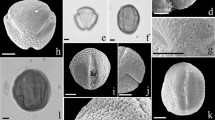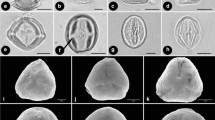Abstract
Pollen morphology of Gyrostemonaceae, Bataceae, andKoeberlinia, which have been affiliated with glucosinolate-producing taxa, was examined by field emission scanning and transmission electron microscopy. Pollen grains of Gyrostemonaceae are tricolpate with scabrate-spinulate surface and have a thick, unstratified exine, while those of Bataceae are tricolporoidate with granular surface and have a thin exine with a single, outermost granular layer. Gyrostemonaceae and Bataceae, which had often been considered sister taxa based on palynological similarity and now are considered more distantly related, have a similar spongy ektexine, but differences between them are evident.Koeberlinia, which is recently considered a sister group to Bataceae+Salvadoraceae (with no spongy ektexine), has tricolporoidate pollen composed of a plesiomorphic, stratified exine with columellae. The totality of evidence indicates that, contrary to earlier observations, pollen of Gyrostemonaceae and Bataceae does not closely resemble each other, and that the spongy ektexine, which looks to be similar in TEM sections, is a homoplasy that evolved independently in the two families.
Similar content being viewed by others
References
Cronquist, A. 1981. An Integrated System of Classification of Flowering Plants. Columbia University Press, New York.
Cronquist, A. 1988. The Evolution and Classification of Flowering Plants. 2nd ed. The New York Botanical Garden, New York.
Erdtman, G. 1952. Pollen Morphology and Plant Taxonomy. Angiosperms. Almquist & Wiksell, Stockholm.
Kushida, H. 1980. An improved embedding method using ERL 4206 and Quetol 653. J. Electron Miscrosc.29: 193–194.
Martin, P.S. andDrew, C.M. 1969. Scanning electron photomicrographs of Southwestern pollen grains. J. Arizona Acad. Sci.5: 147–176.
Mehta, I.J. andMoseley, M.F. Jr. 1981. The floral anatomy ofKoeberlinia Zucc.: systematic implications. Amer. J. Bot.68: 482–497.
Nowicke, J.W. andSkvarla J.J. 1979. Pollen morphology: the potential influence in higher order systematics. Ann. Missouri. Bot. Gard.66: 633–700.
Prijanto, B. 1970a. Gyrostemonaceae. World Pollen Fl. 2: 1–13. Hafner Publishing Co., New York.
Prijanto, B. 1970b. Batidaceae. World Pollen Fl. 3: 1–11. Hafner Publishing Co., New York.
Rodman, J.E. 1991a. A taxonomic analysis of glucosinolate-producing plants, part 1: phenetics. Syst. Bot.16: 598–618.
Rodman, J.E. 1991b. A taxonomic analysis of glucosinolate-producing plants, part 2: cladistics. Syst. Bot.16: 619–629.
Rodman, J.E., Karol, K.G., Price, R.A., Conti, E. andSytsma, K.J. 1994. Nucleotide sequences ofrbcL confirm the capparalean affinity of the Australian endemic Gyrostemonaceae. Aust. Syst. Bot.7: 57–69.
Rodman, J., Price, R.A., Karol, K., Conti, E., Sytsma, K.J. andPalmer, J.D. 1993. Nucleotide sequences of therbcL gene indicate monophyly of mustard oil plants. Ann. Missouri Bot. Gard.80: 686–699.
Roland, F. 1968. Etude de l'ultrastructure des apertures. II. Pollens a sillon. Pollen et Spores10: 479–519.
Roiand, F. 1969. Etude de l'ultrastructure des Apertures. III. Complements fournis par le microscope electronique a Balayage. Pollen et Spores11: 475–498.
Takhtajan, A. 1986. Floristic Regions of the World. University of California Press, Berkeley.
Takhtajan, A. 1987. Systema Magnoliophytorum. Nauka, Leningrad. (In Russian).
Thorne, R.F. 1983. Proposed new realignments in angiosperms. Nord. J. Bot.3: 85–117.
Thorne, R.F. 1992. Classification and geography of the flowering plants. Bot. Rev.58: 225–348.
Tobe, H. andRaven, P.H. 1991. The embryolgy and relationships of Gyrostemonaceae. Aust. J. Bot.4: 407–420.
Walker, J. 1976. Evolutionary significance of the exine in the pollen of primitive angiosperms.In I.K. Ferguson and J. Muller, eds., The Evolutionary Significance of the Exine. pp. 481–498. (Linn. Soc. Symp. Ser. No. 1). Academic Press, London.
Author information
Authors and Affiliations
Additional information
Dedicated to the late Prof. Emer. Kankichi Sohma (August 28, 1926–June 26, 1995), who supervised us for our M. Sc. and D. Sc. programs at Tohoku University, Sendai. He died after his 40 years career in palynology; his wide range of interests and enthusiasm for research, and his unfailing encouragement for students are greatly missed.
Rights and permissions
About this article
Cite this article
Tobe, H., Takahashi, M. Pollen morphology of Gyrostemonaceae, Bataceae andKoeberlinia . J. Plant Res. 108, 283–288 (1995). https://doi.org/10.1007/BF02344354
Received:
Accepted:
Issue Date:
DOI: https://doi.org/10.1007/BF02344354




